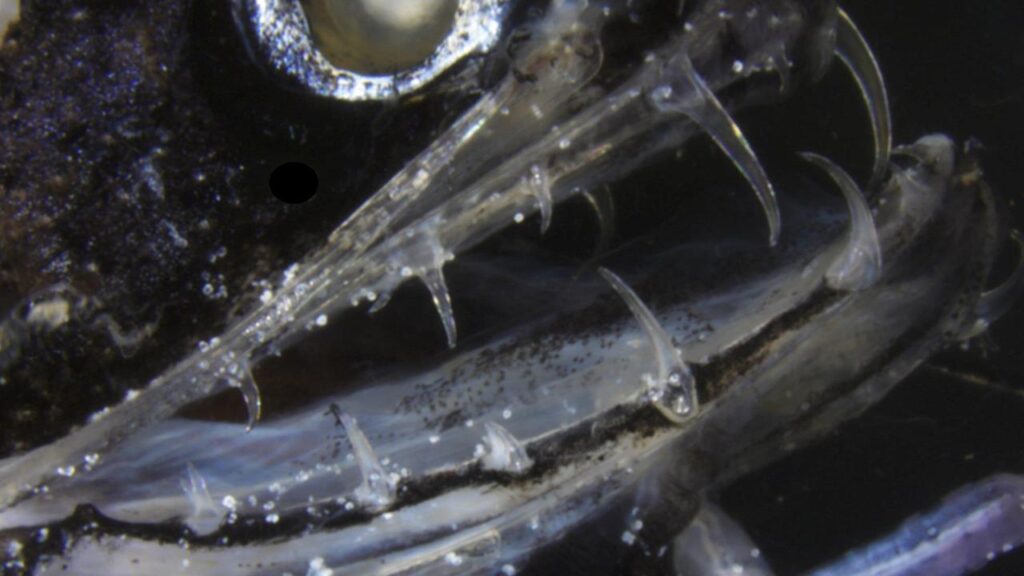
Source:https://ocean.si.edu/
Picture yourself descending into the ocean’s abyss, where sunlight fades to memory, and darkness reigns supreme. Amidst the bioluminescent glow of deep-sea creatures, one species stands out: the Dragonfish.
Often depicted as a fearsome predator, the reality of the Dragonfish is far more captivating than its reputation suggests. Let’s plunge into the depths and unravel the mysteries of this mesmerizing creature.
Kingdom of Darkness: Where Dragonfish Reign
Contrary to their fiery name, Dragonfish (Stomiidae family) aren’t dwelling in shallow reefs. They thrive in the cold, dark depths of the mesopelagic and bathypelagic zones, spanning 200 to 4,000 meters (650 to 13,100 feet) below the surface. This vast, twilight realm is their domain, where they exhibit remarkable adaptations to survive.
Though not the largest of deep-sea inhabitants, Dragonfish can grow up to 30 centimeters (12 inches) in length. Their most striking feature is their bioluminescent barbel, dangling beneath their chin like a glowing beacon. Picture a slender organ emitting an eerie blue-green light, luring unsuspecting prey within reach. This “esca” is their secret weapon, attracting curious victims and allowing the Dragonfish to strike with precision.
But there’s more to their arsenal. Dragonfish possess photophores, tiny light-emitting organs adorning their bodies. These serve not only to mesmerize but also to camouflage, blending them seamlessly with the faint light filtering from above. It’s a display of mastery in deep-sea deception.

Source:https://conservation.reefcause.com/
Yet, despite their fearsome appearance, Dragonfish are opportunistic feeders rather than relentless predators. They roam the depths, utilizing their keen senses and bioluminescent lures to locate prey of all sizes, from small fish to crustaceans.
Beyond the Bite: Unveiling the Secrets of Dragonfish Life
Much of the Dragonfish’s life remains shrouded in mystery. Scientists believe they lay eggs that drift in the open ocean until hatching, but details of their parental care and social behavior remain elusive. Some species are solitary hunters, while others form loose aggregations, their shimmering forms exchanging cryptic signals in the darkness.
Deep-Sea Mysteries: Threats and Conservation

#Dragonfish image
Source:https://www.smorescience.com
Despite their formidable reputation, Dragonfish face threats from deep-sea fishing and habitat degradation. As we strive to understand and mitigate these dangers, conservation efforts become imperative to protect these fascinating creatures and their delicate ecosystem.

Source:https://www.smithsonianmag.com/
Beyond the Glare of Teeth: Why Dragonfish Matter
Dragonfish are not mere monsters of the deep; they are vital components of the ecosystem, playing roles as predators, prey, and sources of bioluminescence. By studying them, we gain insights into the complex workings of the ocean’s depths, fostering a deeper appreciation for its diversity and balance.
Fear often fades in the light of understanding. As we delve into the mysteries of the deep sea, creatures like the Dragonfish emerge as captivating examples of evolution and survival in one of Earth’s most challenging environments.

Source:https://www.kidsnews.com.au/
By exploring their adaptations, life cycle, and ecological significance, we can move beyond sensationalism and recognize them for what they truly are: extraordinary inhabitants of the deep sea, deserving of our curiosity and protection.













